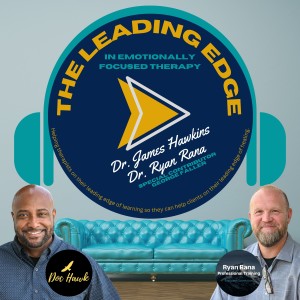
Welcome to the Leading Edge in Emotionally Focused Therapy with Drs. James Hawkins, Ph.D., LPC, and Ryan Rana, Ph.D., LMFT, LPC, ICEEFT Therapists, Supervisors, and Trainers. Thank you for listening. We hope this experience helps you push the leading edge in your work to help people connect with themselves and with each other.
You can financially contribute to this podcast on Venmo (@dochawklpc) or Cash App ($dochawklpc). Type LEFT or Leading Edge in EFT in the comments or notes section. All financial contributions are greatly appreciated and will help us keep producing content to help you push your leading edge.
We desire to use this podcast to help equip therapists with tools and encouragement to help them with relational distress. We are also a part of a team that has created an online training program, Success in Vulnerability (SV). Success In Vulnerability is your premier online education experience that leads with innovative instruction to advance your therapeutic effectiveness through Success in Vulnerability’s exclusive Modules and full-length Clinical Examples.
- You can follow us on our Facebook page @pushtheleadingedge
- You can follow Ryan on Facebook @ryanranaprofessionaltraining and his website com.
- You can follow James on Facebook and Instagram @dochawklpc. You can also check out his website com.
- Check out our online training program com
- You can follow George @ https://www.georgefaller.com/.
2 Lists to Assess Risk
These two lists work together. The more positive variables you have from the first list, the more you can go down the vulnerability ladder with your clients, the second list. You build safety in list one to take more risks on list 2 to push your clients’ leading edge and help them succeed in vulnerability.
List 1 – Risk Assessment: Variables to Consider
Variables to consider when determining the level of Risk you go for. The more of these variables you have, the more Risk you can go for.
- Alliance with the therapist (trust).
- Alliance with the EFT process (trust).
- The number of sessions.
- The number of successful missions (Corrective Emotional Experiences, Bonding Events).
- Tolerance window of the person you are working with and prepping to share.
- Their safety level with their partner.
- Tolerance window of the listening partner.
List 2 – Elements of Experience Risk Ladder
This is just our way to describe the various elements of experience. The further you go down this ladder, the riskier it is. Going up the ladder is slicing it thinner.
- Protective Behaviors
- Secondary Emotion (Emotion that is used to create space vs. create connection)
- Story Construction About Distressed Relationship (Meaning)
- What They Think (What they say it means about them, others, the relationship)
- Recognition of Danger Cues/Triggers
- Primary Emotion (Emotion that is used to create connection vs. create space)
- Hang Out and Stay in Primary Emotion
- Individual Trauma
- Attachment Injuries
- Vulnerable View of Self
- Attachment Needs – When they are in distress
No comments yet. Be the first to say something!